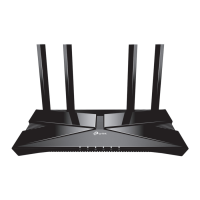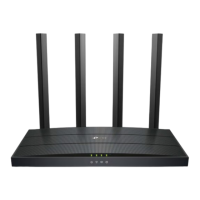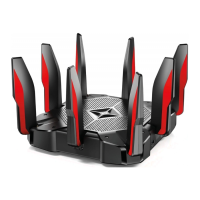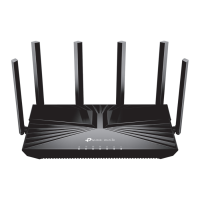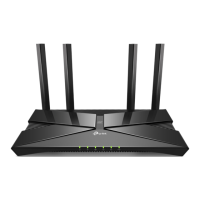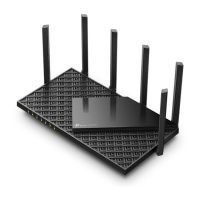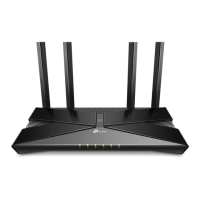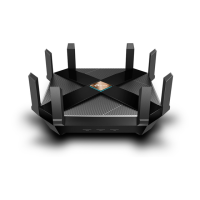
Do you have a question about the TP-Link AX17 and is the answer not in the manual?
| Wireless Standard | Wi-Fi 6 (802.11ax) |
|---|---|
| Antennas | 4 external antennas |
| Frequency Bands | 2.4 GHz and 5 GHz |
| Wi-Fi Speed | 1201 Mbps at 5 GHz |
| Security | WPA3 |
| Features | OFDMA, MU-MIMO, Beamforming, Parental Controls |
Explains symbols, formatting, and notes used throughout the guide.
Describes the router's next-generation Wi-Fi technology and performance benefits.
Details the physical layout of the router, including the top panel and LEDs.
Explains the meaning of different LED statuses for router and access point modes.
Details the ports, buttons, and antennas on the router's back panel.
Provides guidance on the optimal placement of the router for best performance and safety.
Outlines the steps for physically connecting the router and modem using Ethernet cables.
Explains wired, wireless, and WPS methods for connecting devices to the router.
Guides users on how to access and log into the router's web management interface.
Guides users through an automated process to configure the router for internet connection.
Provides steps to manually configure internet connection settings based on ISP information.
Details how to configure the router to function as an access point for an existing network.
Guides on configuring the router for an IPv6 internet connection, covering different types.
Provides step-by-step instructions for registering a new TP-Link ID for cloud services.
Guides on using the TP-Link Tether app for managing the router from smart devices.
Explains how the Network Map visually displays device connectivity and network settings.
Describes how to view and block client devices connected to the network.
Guides on customizing Wi-Fi network name (SSID), password, and security options.
Explains how to schedule the wireless network to turn on or off automatically.
Details how to use Wi-Fi Protected Setup (WPS) for secure wireless connections.
Instructions for adding another TP-Link router as a satellite device in an EasyMesh network.
How to view and manage mesh devices and connected clients through the main router.
Guides on creating a separate Wi-Fi network for guests with custom SSID and security.
Options to control guest network access, allowing guests to see each other or the local network.
How to block content and set internet access time limits for specific devices or family members.
Instructions on how to view reports of websites visited and time spent online by children.
Explains how to enable QoS and allocate bandwidth for specific devices or applications.
Details the SPI Firewall's role in protecting the network from cyber threats and validating traffic.
How to block or allow specific devices to access the network using blacklists or whitelists.
Binds IP addresses to MAC addresses to prevent ARP spoofing and unauthorized access.
How to share local network resources like web servers with the internet using port forwarding.
Configures a PC as a DMZ host, exposing it to the internet for unrestricted communication.
Enables UPnP to automatically open ports for smoother online gaming experiences.
Guides on setting up an OpenVPN server on the router for secure remote access to the home network.
Details setting up a PPTP VPN server on the router for simpler remote access.
How to change the router's LAN IP address and subnet mask for network compatibility.
How to configure the DHCP server, IP address pool, and reserve IP addresses for clients.
Instructions for setting up DDNS to access the router remotely using a domain name.
Guides on performing online or local firmware upgrades for the router.
How to backup, restore, or reset router configuration settings to default.
Instructions for changing the web management login password for the router.
Configures remote access authority to manage the router over the internet.
Uses Ping or Traceroute tools to test network connectivity between the router and other devices.
Steps to retrieve or reset the wireless password if it has been altered.
How to reset the web management password using TP-Link ID or the reset button.
Troubleshooting steps for issues preventing login to the router's web management page.
Solutions for internet access problems, including DNS configuration and modem/router restarts.
Steps to troubleshoot issues with finding or connecting to a wireless network.
